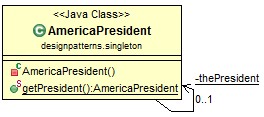单例模式
单例模式(Singleton Pattern)在java中算是最常用的设计模式之一,主要用于控制控制类实例的数量,防止外部实例化或者修改。单例模式在某些场景下可以提高系统运行效率。实现中的主要特点有以下三点:
- 私有构造函数(private constructor):其他的类不能实例化此类的对象。
- 私有化引用(private reference): 类之外不能修改。
- 存在唯一的实例化对象的静态方法。
下面以美国只有一个总统的例子对单例模式进行形象化说明。
类图
代码

1 package patterns; 2 3 public class AmericaPresident { 4 5 private static AmericaPresident aAmericaPresident; 6 7 private AmericaPresident(){} 8 9 public static AmericaPresident getAmericaPresidentInstance(){ 10 if(aAmericaPresident == null) 11 aAmericaPresident = new AmericaPresident(); 12 return aAmericaPresident; 13 } 14 15 public static void testAmericanPresidentInstance(){ 16 System.out.println(aAmericaPresident.hashCode()); 17 } 18 19 public static void main(String[] args){ 20 AmericaPresident americaPresident_1 = AmericaPresident.getAmericaPresidentInstance(); 21 americaPresident_1.testAmericanPresidentInstance(); 22 AmericaPresident americaPresident_2 = AmericaPresident.getAmericaPresidentInstance(); 23 americaPresident_2.testAmericanPresidentInstance(); 24 } 25 }
输出
580487944
580487944
结论
两次实例化的对象的哈西直相同,说明第二次实例化的事后没有真正的进行实例化,返回的是第一次实例化的对象。

